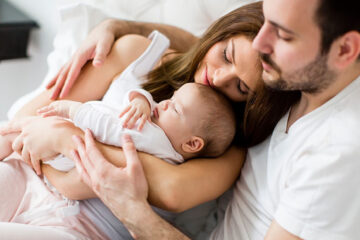A baby may show signs of being cold at night through fussiness or shivering. It is important to identify these signs to ensure their comfort and well-being.
When a baby feels cold, their body temperature drops below the normal range, causing discomfort and potential health risks. To keep your little one warm and cozy during the night, it is essential to understand the signs that indicate their discomfort.
By paying attention to these signs, you can take appropriate measures to keep your baby warm and ensure a restful night’s sleep for both of you.
Identifying Signs Of Cold
As parents, it’s important to closely monitor our little ones to ensure their comfort and well-being, especially during chilly nights. Even with the warmth of blankets and onesies, babies can still feel cold. So how can we identify if our baby is feeling cold at night? Let’s take a look at some signs to watch out for:
Chilly To The Touch
One of the easiest ways to tell if your baby is feeling cold is by touching their skin. Feel their hands, feet, and the back of their neck. A baby who is too cold may have skin that feels abnormally cool or even cold to the touch. This is a clear indication that your little one needs some extra layers to stay warm.
Crying And Fussiness
When a baby feels cold, their body responds by crying and becoming fussy. Babies communicate through their cries. If your little one is excessively crying or fussing during the night, it could be a sign that they are feeling uncomfortable due to the cold. Comforting them with extra layers and warmth can help soothe their distress.
Pale Skin
Babies with cold skin often have a paler complexion than usual. The coldness constricts blood vessels, causing the skin to appear paler than its usual rosy hue. If you notice your baby’s skin looking unusually pale, it’s a telltale sign that they might be feeling cold and in need of additional layers to keep warm.
Physical Indicators
As a parent, it is crucial to understand the physical indicators that indicate your baby may be feeling cold at night. These signs will help you ensure that your little one is kept warm and comfortable during the night. In this section, we will discuss three common physical indicators to look out for: shivering, cold hands and feet. By recognizing these signs, you can take appropriate measures to keep your baby warm and snug.
Shivering
Shivering is one of the most evident signs that your baby is feeling cold. When a baby shivers, it is their body’s way of generating heat to compensate for the drop in temperature. If you notice your little one shivering, it is crucial to take immediate action to warm them up. Here are a few steps you can follow:
- Check the temperature of the room – Ensure that the room is at an adequate temperature for your baby. Ideally, the room temperature should be between 68-72 degrees Fahrenheit (20-22 degrees Celsius).
- Add extra layers – If the room temperature is within the desired range and your baby is still shivering, consider adding an extra layer of clothing or using a thicker blanket to provide added warmth.
- Skin-to-skin contact – If your baby continues to shiver despite the above measures, try holding them close to your body, ensuring skin-to-skin contact. This will help transfer your body heat to your little one and regulate their body temperature.
By addressing the issue of shivering promptly, you can ensure your baby’s comfort and prevent them from becoming too cold during the night.
Cold Hands And Feet
Another physical indicator that your baby may be feeling cold is if their hands and feet feel cold to the touch. This is usually a result of reduced blood circulation to these extremities in response to the cold. To keep your baby’s hands and feet warm:
- Dress appropriately – Ensure that your baby is dressed in comfortable, yet warm clothing, with additional layers covering their extremities. Consider using mittens or socks specifically designed to retain heat.
- Use warm but not hot water – If your baby’s hands and feet feel cold, you can warm them up by gently washing and drying them using warm water. It is important to avoid using hot water as it may cause burns.
- Massage their hands and feet – Rubbing your baby’s hands and feet gently can help stimulate blood circulation and warm them up.
By paying attention to the temperature of your baby’s hands and feet, you can ensure that they remain cozy and comfortable throughout the night.
Behavioral Clues
Behavioral Clues: Signs Baby is Cold at Night
Trouble Sleeping
Baby having trouble sleeping can indicate that they are feeling cold at night. When the room temperature is too cold, it can disrupt their sleep pattern, causing them to wake up frequently throughout the night.
Here are some behavioral clues that your baby may be experiencing trouble sleeping due to being cold:
- Frequent tossing and turning while trying to sleep.
- Restlessness, often accompanied by crying or fussiness.
- Difficulty falling asleep and staying asleep for longer periods of time.
- Waking up abruptly from deep sleep and struggling to settle back down.
Excessive Waking Up
Excessive waking up during the night can be a clear signal that your baby is feeling too cold. When their body temperature drops below a certain level, they may wake up frequently in search of warmth.
Here are a few behavioral cues to look out for if your baby is waking up excessively due to being cold:
- Frequent cries for attention and comfort throughout the night.
- A strong desire to be held or cuddled, seeking warmth from your body.
- Clammy or cold skin when you touch their hands or feet.
- Visible shivering or trembling, especially when waking up or during feeds.
Preventive Measures
Ensuring that your baby stays warm and comfortable during night time is essential for their well-being. By taking some simple preventive measures, you can make sure that your little one is snug and cozy, even on the chilliest of nights. Proper dressing, room temperature regulation, and careful attention to detail can go a long way in keeping your baby warm throughout their sleep. Follow these helpful tips to keep your baby warm and help them get a restful night’s sleep.
Proper Dressing
In order to keep your baby warm during the night, it is crucial to dress them in appropriate clothing. Opt for soft, breathable fabrics such as cotton or fleece that provide warmth without causing overheating. A good rule of thumb is to dress your baby in one additional layer than what you are comfortable in. For instance, if you’re comfortable in a t-shirt and light pajamas, dress your baby in a onesie, a sleeper, and a light blanket. It is important to avoid overdressing, as it can lead to excessive sweating and discomfort.
Room Temperature Regulation
The temperature of your baby’s room plays a significant role in ensuring their comfort and warmth at night. It is recommended to maintain a room temperature between 68-72 degrees Fahrenheit (20-22 degrees Celsius). To achieve this, you can use a room thermometer to monitor the temperature accurately. Additionally, you can adjust the thermostat or use a space heater to keep the room at a consistent and comfortable temperature throughout the night. Remember to keep the room well-ventilated to prevent stuffiness.
If you live in an area with extremely cold winters, you can also consider using a humidifier in the room. Cold air tends to be dry, and a humidifier can help add moisture to the air, preventing dryness and keeping your baby’s skin hydrated.
Frequently Asked Questions Of Signs Baby Is Cold At Night
Q: How Can I Tell If My Baby Is Feeling Cold At Night?
A: Look for signs like cold hands and feet, fussing, or difficulty sleeping to determine if your baby is feeling cold at night.
Q: What Should My Baby Wear To Bed If They Are Feeling Cold?
A: Dress your baby in warm and cozy clothing, such as a onesie or a sleep sack, to keep them comfortable and warm at night.
Q: Is It Normal For A Baby’s Nose To Feel Cold At Night?
A: Yes, it is normal for a baby’s nose to feel slightly cool to the touch, as long as the rest of their body feels warm and they seem comfortable.
Q: Should I Use A Heater In My Baby’s Room During Cold Nights?
A: It’s generally recommended to avoid using a heater in your baby’s room. Instead, dress them in warm clothing and use a sleep sack to keep them cozy.
Q: Are Cold Hands And Feet A Sign Of A Medical Issue In Babies?
A: Cold hands and feet are usually not a cause for concern in babies, as it is often a normal response to keep the vital organs warm. However, if you notice any other worrisome symptoms, consult your pediatrician.
Q: How Can I Ensure My Baby Stays Warm During Winter Nights?
A: Keep the room temperature between 68-72°F, dress your baby in warm clothing, use a sleep sack, and avoid drafts to ensure your baby stays warm during winter nights.
Q: Can A Baby Feel Cold Even If The Room Is Warm?
A: Yes, babies lose heat faster than adults, so they may feel cold even in a room that feels warm to you. It’s important to dress them appropriately for the temperature.
Q: What Are The Risks Of A Baby Getting Too Cold At Night?
A: Babies getting too cold at night can be at risk of hypothermia, poor sleep quality, and a weakened immune system. Keep your baby comfortably warm to avoid these risks.
Conclusion
It is crucial for parents to be able to recognize the signs that their baby may be feeling cold at night. By paying attention to their baby’s behavior, monitoring their body temperature, and taking necessary steps to ensure warmth, parents can create a comfortable and safe sleeping environment.
Prioritizing their baby’s comfort will contribute to better sleep quality and overall well-being.




